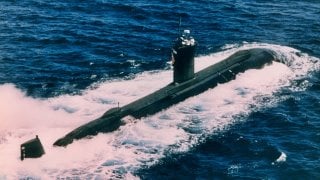A U.S. Navy Deep-Diving 'Research' Submarine Caught Fire and Flooded
In May 2002, the Navy research submarine USS Dolphin caught fire and partially flooded near San Diego while resurfacing to recharge its batteries.
What You Need to Know: In May 2002, the Navy research submarine USS Dolphin caught fire and partially flooded near San Diego while resurfacing to recharge its batteries.
-All 43 crew members survived, but two civilians fell overboard and were rescued by the Coast Guard. The Dolphin, known for its deep-sea research capabilities, underwent three years of repairs before returning to service.
-However, budgetary constraints led to its decommissioning in 2006. Built in the 1960s, the Dolphin was renowned for record-breaking depth capabilities and numerous technological firsts. Today, it is displayed at the San Diego Maritime Museum.
How Navy Submarine USS Dolphin Survived a Fire and Flood Off San Diego’s Coast
Over two decades ago a Navy research submarine caught fire and partially flooded off the coast of San Diego. USS Dolphin (AGSS-555) was manned by forty-three crew members at the time, who all survived the incident. Since this vessel functioned as the Navy’s sole diesel-electric research submarine at the time, her eventual decommissioning was a blow to the service.
USS Dolphin Overview
Built under the guidance of the Ship Characteristics Board, the USS Dolphin was developed to provide essential capabilities to the service. Specifically, Dolphin was conceptualized to be easily modified internally and externally and enable the incorporation of military and civilian research equipment.
In the early 1960s, her keel was laid at the Portsmouth Navy Yard in Maine and launched a few years later. Uniquely, Dolphin’s “555” hull number was taken out of sequential order. The submarine’s “555” designation was derived from the canceled class of Tench submarines which were discontinued following the Second World War.
What Made the Dolphin So Essential
Unlike her predecessors who were built for speed, the Dolphin was designed primarily to be able to withstand the hefty pressures found at extreme depths. The mighty research submarine was said to be able to function at greater depths than any other submarine across the globe during the time of her commissioning.
The Dolphin could sail so deep underwater that engineers incorporated a single hatch on the submarine to, “keep any irregularities in the hull, such as hatches, to a minimum,” according to the Defense Medium Network.
In terms of technologies, Dolphin was equipped with the then-cutting-edge Submarine Safety Monitoring System (SSMS). This sensor not only tracked vital measurements such as pressures and temperatures but would also sound the alarm if necessary. The Navy and civilian research groups employed Dolphin to support deep-water and littoral research, sensor trials, and weapons tests.
Throughout her service years, Dolphin achieved many “firsts,” including launching a torpedo from the deepest depth ever fired. Additionally, the research submarine conducted the first successful test of the BQS-15 sonar system and the first ship of its kind to carry out successful submarine-to-aircraft optical communications.
The Incident
While sailing close to San Diego in May 2002, Dolphin suffered a flood while resurfacing to recharge its batteries. A fire was then caused after the influx of water resulted in short circuits on board. While disaster was averted by the heroic actions of crew members, those on board still had to be evacuated and two civilians needed to be rescued by the Coast Guard after falling into the water. Dolphin would then spend the next three years undergoing repairs and would return to service in 2005.
However, one year later, the Navy decided to decommission the research submarine due to budgetary constraints. Dolphin was officially transferred to the San Diego Maritime Museum in 2008, where she remains available for public viewing today.
About the Author: Maya Carlin, Defense Expert
Maya Carlin, National Security Writer with The National Interest, is an analyst with the Center for Security Policy and a former Anna Sobol Levy Fellow at IDC Herzliya in Israel. She has by-lines in many publications, including The National Interest, Jerusalem Post, and Times of Israel. You can follow her on Twitter: @MayaCarlin.
Image Credit: Creative Commons and/or Shutterstock.


